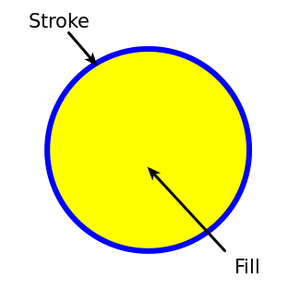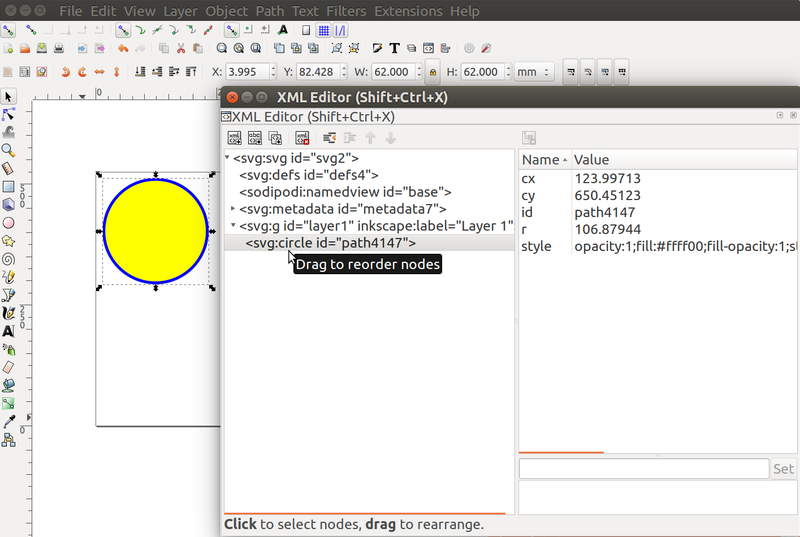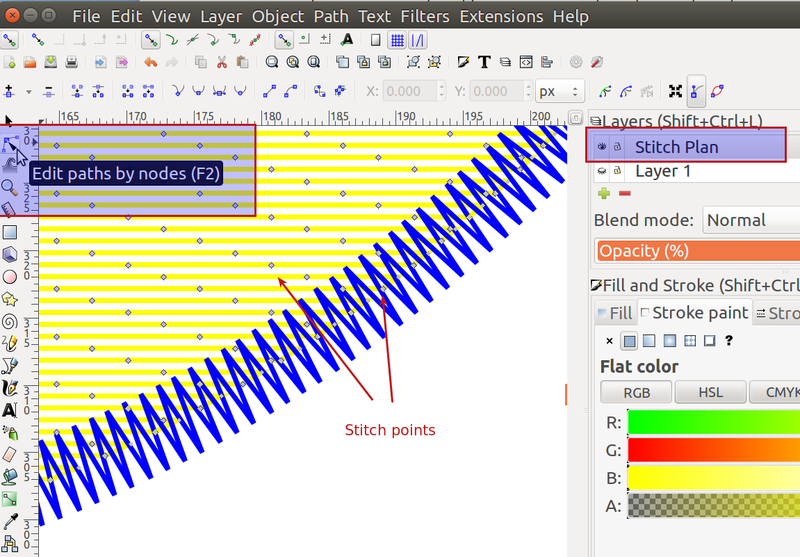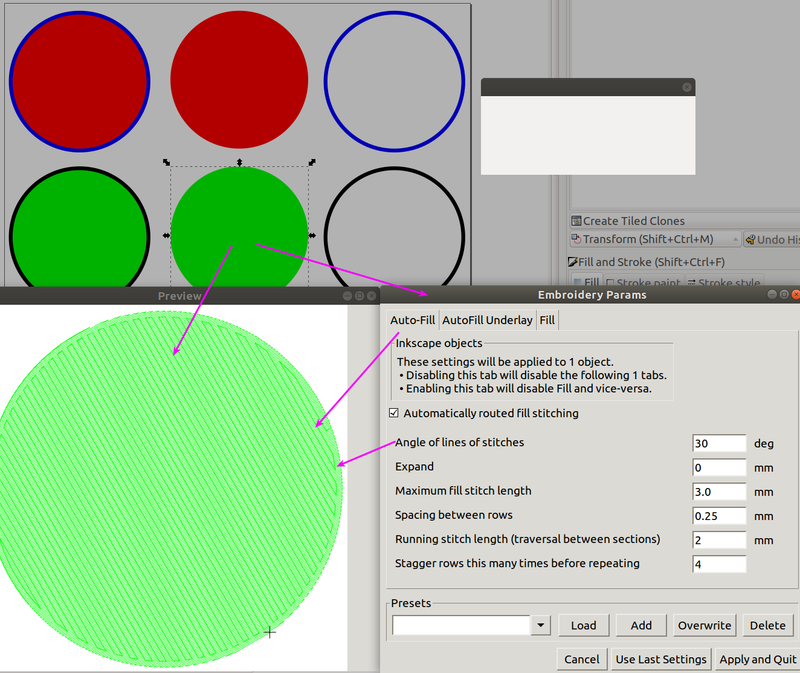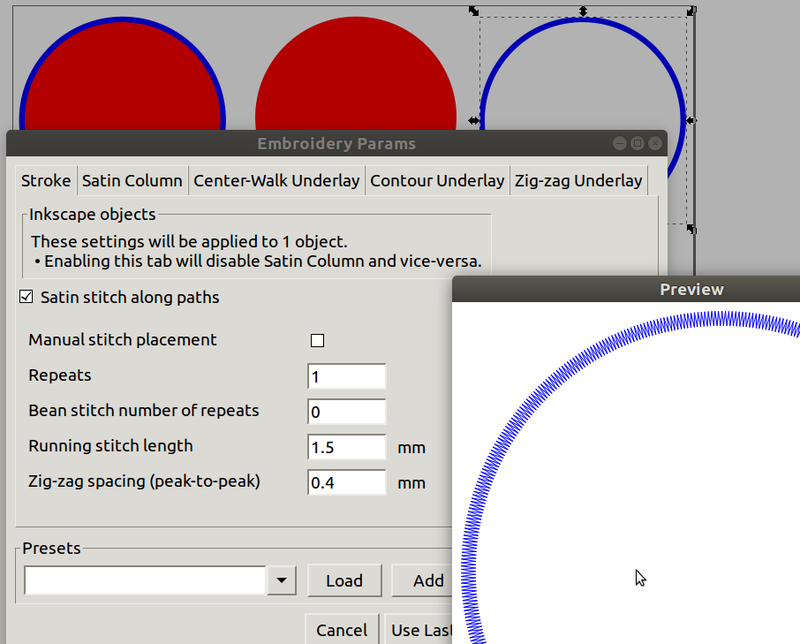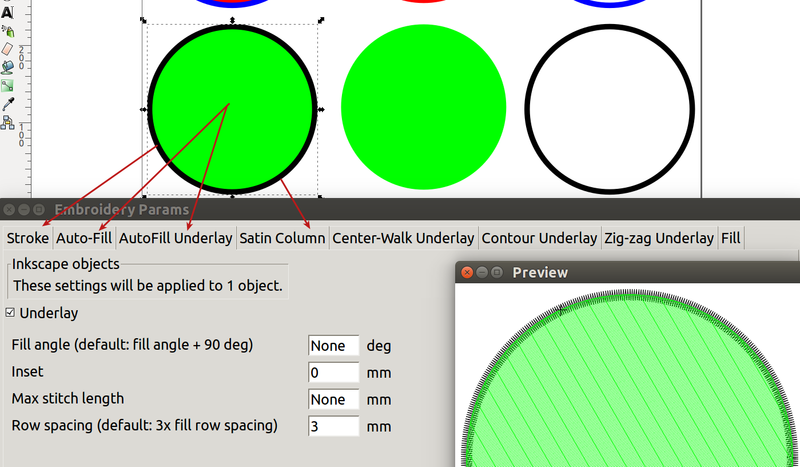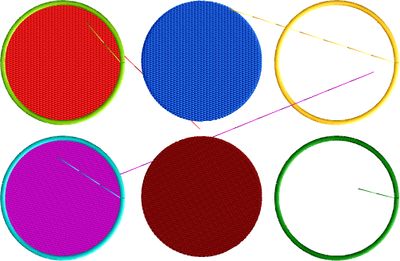InkStitch - basic use
Basic use of InkStitch
You can try to following steps in order to test the extension and to learn about basic functionality.
Step 1 - draw an object
Create an object, e.g. a circle. You can use both fill and stroke. Below is an example and its SVG code.
The SVG code defining the object uses the SVG circle tag.
<circle
style="opacity:1;fill:#ffff00;fill-opacity:1;stroke:#0000ff;stroke-width:5.92615652;stroke-miterlimit:4;stroke-dasharray:none;stroke-opacity:1"
id="path4147"
cx="123.99713"
cy="650.45123"
r="106.87944" />
You can open the builtin XML tree editor if you want to check the code (CTRL-SHIFT-X)
Step 2 - convert to path
Transform all objects you want to stitch to paths:
- Select all object(s), e.g. hit CTRL+A
- Menu Path->Object to Path
An SVG Path includes both numbers representing positions and letters representing drawing and moving operations, including Bezier curves and Arcs. You do not need to understand how this works. Only make sure that all objects you plan to stitch are represented by a path. To check this, open the XML editor, then click on the object in the workspace. The XML code will be highlighted.
<path
style="opacity:1;fill:#ffff00;fill-opacity:1;stroke:#0000ff;stroke-width:5.92615652;stroke-miterlimit:4;stroke-dasharray:none;stroke-opacity:1"
d="M 230.87657,650.45123 A 106.87944,106.87944 0 0 1 123.99713,757.33067 106.87944,106.87944 0 0 1 17.117691,650.45123 106.87944,106.87944 0 0 1 123.99713,543.57179 106.87944,106.87944 0 0 1 230.87657,650.45123 Z"
id="path4147" />
Objects that are not of "Path" type, are ignored by InkStitch (remember that!)
Step 3 - Parametrize SVG path for embroidery
Select at leas one object. In menu Extensions -> Embroider -> Select Params and play with them. There are actually quite a lot compared to other SVG to embroidery translators.
For now, we just suggest accepting the defaults. We shall explain more parametrization in the next section. You also will learn later that InkStitch will add properties to SVG paths, defining how stitch objects should be created from each drawing.
Step 4 - Create the Embroidery file
You can either create a stitch file for a selection of objects or for all path objects. To create an embroidery file for the whole design:
- Click into some empty space (in order to deselect)
- Menu Extensions -> Embroider -> Embroidery
- Select the format of your machine. In case you are unhappy with the result, select a widely used format such as Tajima (DST) and then use a free translator to convert to your proprietary format.
- Type a directory name where you can find your files, e.g. c:\users\__you__\Desktop on windows or /home/schneide/schneide/embroidery/inkstitch under Linux. The file will remember this information.
You can skip the next step providing some technical details about how embroidery objects are represented in Inkscape.
Step 5 - Inspect in Inkscape
You now also will have a new layer that includes the Stitch Plan, i.e. the objects that have been exported as Stitch objects. You can check this to visualize the points that will be stitched. Alternatively you could use an embroidery viewer
In order to examine the Stitch points
- select the Stitch Plan layer and hide the others (this should be done automatically after using the Embroidery operation).
- Select the Edit Path tool in Inkscape
- Zoom in
If you look at the SVG code, you can see that your path are now annotated with stitching information. In addition, the new stitch plan layer contains two huge path objects - one for the border and one for the fill - that define all the points to be stitched, plus the stroke color for both. Since the circle was split into two objects with strokes, there is of course no more fill.
Simple embroidery parametrization of SVG objects
InkStitch can produce four kinds of stitch packs from an SVG object: Running stitches, simple zigzag, satin columns and fill stitches.
- A filled stitch area from SVG path with
filldefined - Simple zigzag or running stitches (lines) from SVG objects with
strokedefined - Two objects (an area and a zigzag/line) from a path that has both fill and stroke
- Satin stitches from a path that includes two "polyline" subpaths
If we understood right:
- SVG Fills can only translate to areas (also called tatami stitches or fills)
- Strokes translate to simple zigzag or simple lines
- Two strokes with the same amount of nodes can translate to satin columns
Paths with fills to embroidery areas
SVG fills are translated to areas filled with a simple linear pattern. You can define an underlay, density and orientation (rotation), and add trim and stop code, i.e. have the machine cut the thread and/or stop.
In order to parametrize a fill:
- Select an path object that has a fill and no stroke (e.g. something like the green or the red circle below)
- Open the parameter popup window: Menu Extensions -> Embroidery -> Params
You will see a little popup that say "Params working, please wait". Just move it out of the way and ignore it. Now look at the Embroidery Params popup window. It will have three tabs (see grey popup in the next screen capture).
- Auto-Fill: Try to change the fill angle. You can also can add STOP and Trim code if they are supported by the stitch file.
- AutoFill Underlay: Add an underlay, i.e. stitches that will be stitched underneath the pattern. This will add some stability and also a little 3D effect. Do not make it too dense.
- Fill: An alternative to auto fill
Paths with strokes to zigzag stitches
SVG strokes are translated to simple zigzag or satin stitches that can have an underlay. If you open again the Param popup (Menu Extensions -> Embroidery -> Params), you will see different tabs:
- Stroke (used by default)
- Satin Column
- Center-Walk Underlay
- Contour Underlay
- Zig-Zag Underlay
By default, there will be a simple Satin stitch (i.e. a zigzag) for a fat stroke, as shown in the following screenshot. Ignore the satin column, since InkStitch cannot translate simple strokes to satin columns.
- Small zigzags are difficult to stitch since they pull and distort the tissue a lot. If you can, go for line thickness between 2 and 3 mm. Otherwise, use less density.
Paths with fills and strokes
Objects that have both fill and stroke will allow parametrization of both, i.e. the param popup will present the combined tabs from the area and stroke parameters.
If we understand right, strokes of objects that allows have fills can only translate to simple zigzag, not satin stitches that create rounded corners. Workaround:
- Copy paste (in place) the object
- Remove the fill from one of these
- Remove the stroke from the other.
Summary
InkStitch provides good basic functionality for creating Stitch files with Inkscape.
The stitch file in Tajima DST format was accepted by our multi-needle machine, but I did not stitch the design since it is not really interesting.
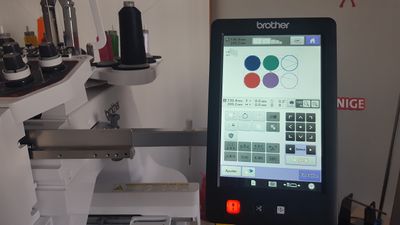 Stitch file accepted by our Brother PR1050X |
Remarks:
- Colors are wrong since the thread palette used in the viewer of Stitch Era and the embroidery machine are different from the default. Thread palettes are difficult to understand...
- There are some extra extra stitch sections that should not be stitched (the little lines).
In this section we just presented basic functionality. In particular, InkStitch allows creation of satin colums from more or less parallel lines and also simple lines.
